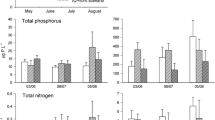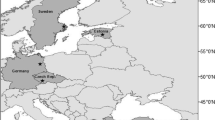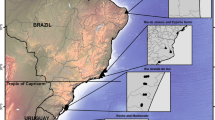Abstract
We aimed to investigate the influence of environmental factors and predict zooplankton biomass and abundance in shallow eutrophic lakes. We employed time series of zooplankton and environmental parameters that were measured monthly during 38 years in a large, shallow eutrophic lake in Estonia to build estimates of zooplankton community metrics (cladocerans, copepods, rotifers, ciliates). The analysis of historical time series revealed that air temperature was by far the most important variable for explaining zooplankton biomass and abundance, followed, in decreasing order of importance, by pH, phytoplankton biomass and nitrate concentration. Models constructed with the best predicting variables explained up to 71% of zooplankton biomass variance. Most of the predictive variables had opposing or antagonistic interactions, often mitigating the effect of temperature. In the second part of the study, three future climate scenarios were developed following different Intergovernmental Panel on Climate Change (IPCC) temperature projections and entered into an empirical model. Simulation results showed that only a scenario in which air temperature stabilizes would curb total metazooplankton biomass and abundance. In other scenarios, metazooplankton biomass and abundance would likely exceed historical ranges whereas ciliates would not expand. Within the metazooplankton community, copepods would increase in biomass and abundance, whereas cladocerans would lose in biomass but not in abundance. These changes in the zooplankton community will have important consequences for lake trophic structure and ecosystem functioning.



Similar content being viewed by others
References
Agasild H, Zingel P, Tõnno I, Haberman J, Nõges T (2007) Contribution of different zooplankton groups in grazing on phytoplankton in shallow eutrophic Lake Võrtsjärv (Estonia). Hydrobiologia 584:167–177
Agasild H, Zingel P, Karus K, Kangro K, Salujoe J, Noges T (2013) Does metazooplankton regulate the ciliate community in a shallow eutrophic lake? Freshw Biol 58:183–191
Akaike H (1973) Information theory and an extension of the maximum likelihood principle. In: Petrov BN (ed) Proceedings of the second international symposium on information theory. Akademiai Kiado, Budapest, pp 267–281
Atkinson D, Ciotti BJ, Montagnes DJS (2003) Protists decrease in size linearly with temperature: ca. 2.5% degrees C−1. Proc Biol Sci 270:2605–2611
Brucet S, Boix D, Quintana XD, Jensen E, Nathansen LW, Trochine C, Meerhoff M, Gascón S, Jeppesen E (2010) Factors influencing zooplankton size structure at contrasting temperatures in coastal shallow lakes: implications for effects of climate change. Limnol Oceanogr 55:1697–1711
Burberg C, Ilic M, Petzoldt T, Von Elert E (2019) Nitrate determines growth and protease inhibitor content of the cyanobacterium Microcystis aeruginosa. J Appl Phycol 31:1697–1707
Burns CW, Brett MT, Schallenberg M (2011) A comparison of the trophic transfer of fatty acids in freshwater plankton by cladoceran and calanoid copepods. Freshw Biol 56:889–903
R Core Team (2019) R: a language and environment for statistical computing. R Foundation for Statistical Computing, Austria, Vienna https://www.R-project.org (accessed February 2019)
Crawley MJ (2013) The R book, 2nd edn. Wiley
Cremona F, Tuvikene L, Haberman J, Nõges P, Nõges T (2018) Factors controlling the three-decade long rise in cyanobacteria biomass in a eutrophic shallow lake. Sci Total Environ 621:352–359
Feld CK, Segurado P, Gutiérrez-Canovas T (2016) Analysing the impact of multiple stressors in aquatic biomonitoring data: a “cookbook” with applications in R. Sci Total Environ 573:1320–1339. https://doi.org/10.1016/j.scitotenv.2016.06.243
Forster J, Hirst AG, Esteban GF (2013) Achieving temperature-size changes in a unicellular organism. ISME J 7:28–36
Gaedke U, Wickham SA (2004) Ciliate dynamics in response to changing biotic and abiotic conditions in a large, deep lake (Lake Constance). Aquat Microb Ecol 34:247–261
George DG, Harris GP (1985) The effect of climate on long-term changes in the crustacean zooplankton biomass of Lake Windermere, UK. Nature 316:536
Gerten D, Adrian R (2002) Species-specific changes in the phenology and peak abundance of freshwater copepods in response to warm summers. Freshw Biol 47:2163–2173
Gillooly JF, Dodson SI (2000) Latitudinal patterns in the size distribution and seasonal dynamics of new world, freshwater cladocerans. Limnol Oceanogr 45:22–30
Gliwicz ZM, Lampert W (1990) Food thresholds in daphnia species in the absence and presence of bluegreen filaments. Ecology 71:691–702
Greenwell B, Boemke B, Cunningham J, et al (2018) Gbm: generalized boosted regression models. R Package Version 2.1.1. http://CRAN.R-project.org/package=gbm (accessed December 2018)
Haberman J (1998) Zooplankton of Lake Võrtsjärv. Limnologica 28:49–65
Haberman J, Haldna M (2017) How are spring zooplankton and autumn zooplankton influenced by water temperature in a polymictic lake? Proc Est Acad Sci 66:264–278
Hansen A-M, Santer B (1996) The influence of food resources on the development, survival and reproduction of the two cyclopoid copepods: Cyclops vicinus and Mesocyclops leuckarti. J Plankton Res 17:631–646
Harrell FE (2001) Regression modeling strategies: with applications to linear models, logistic regression, and survival analysis. Springer, New York
Hijmans RJ, Phillips S, Leathwick J, Elith J (2016) Dismo: species distribution modeling. R Package Version 1.0–15. http://CRAN.R-project.org/package=dismo (accessed December 2018)
Hopp U, Maier G (2005) Implication of the feeding limb morphology for herbivorous feeding in some freshwater cyclopoid copepods. Freshw Biol 50:742–747
Hyndman R, Athanasopoulos G, Bergmeir C, Caceres G, Chhay L, O’Hara-Wild M, Petropoulos F, Razbash S, Wang E, Yasmeen F (2018) Forecast: forecasting functions for time series and linear models. R package version 8.4 https://cran.r-project.org/web/packages/forecast/index.html (accessed December 2018)
Iglesias C, Mazzeo N, Meerhoff M, Lacerot G, Clemente JM, Scasso F, Kruk C, Goyenola G, García-Alonso J, Amsinck SL, Paggi JC (2011) High predation is of key importance for dominance of small-bodied zooplankton in warm shallow lakes: evidence from lakes, fish exclosures and surface sediments. Hydrobiologia 667:133–147
Janatian N, Olli K, Cremona F, Laas A, Nõges P (2019) Atmospheric stilling offsets the benefits from reduced nutrient loading in a large shallow lake. Limnol Oceanogr 9999:1–15
Jeppesen E, Meerhoff M, Jacobsen BA, Hansen RS, Søndergaard M, Jensen JP, Lauridsen TL, Mazzeo N, Branco CWC (2007) Restoration of shallow lakes by nutrient control and biomanipulation—the successful strategy varies with lake size and climate. Hydrobiologia 581:269–285
Jeppesen E, Meerhoff M, Davidson TA, Trolle D, Søndergaard M, Lauridsen TL, Beklioglu M, Brucet S, Volta P, Gonzalez-Bergonzoni I, Nielsen A (2014) Climate change impacts on lakes: an integrated ecological perspective based on a multi-faceted approach, with special focus on shallow lakes. J Limnol 73:88–111
Kalff J (2002) Limnology. Prentice Hall, Upper Saddle River, New Jersey
Lydersen E, Aanes KJ, Andersen S, Andersen T, Brettum P, Baekken T, Lien L, Lindstrøm EA, Løvik JE, Mjelde M, Oredalen TJ, Solheim AL, Romstad R, Wright RF (2008) Ecosystem effects of thermal manipulation of a whole lake, Lake Breisjøen, southern Norway (THERMOS project). Hydrol Earth Syst Sci 12:509–522
Mack L, Andersen HE, Beklioğlu M, Bucak T, Couture RM, Cremona F, Ferreira MT, Hutchins MG, Mischke U, Molina-Navarro E, Rankinen K (2019) The future depends on what we do today–projecting Europe’s surface water quality into three different future scenarios. Sci Total Environ 668:470–484
Maier G (1989) The effect of temperature on the development times of eggs, naupliar and copepodite stages of 5 species of cyclopoid copepods. Hydrobiologia 184:79–88
Martin-Creuzburg D, Von Elert E, Hoffmann KH (2008) Nutritional constraints at the cyanobacteria-Daphnia magna interface: the role of sterols. Limnol Oceanogr 53:456–468
Mooij WM, Hülsmann S, De Senerpont Domis LN, Nolet BA, Bodelier PLE, Boers PCM, Pires LMD, Gons HJ, Ibelings BW, Noordhuis R, Portielje R (2005) The impact of climate change on lakes in the Netherlands: a review. Aquat Ecol 39:381–400
Moss B, Stephen D, Balayla DM, Bécares E, Collings SE, Fernández-Aláe C, Fernández-Aláez M, Ferriol C, García P, Gomá J, Gyllström M (2004) Continental-scale patterns of nutrient and fish effects on shallow lakes: synthesis of a pan-European mesocosm experiment. Freshw Biol 49:1633–1649
Moss B, Kosten S, Meerhoff M, Battarbee RW, Jeppesen E, Mazzeo N, Havens K, Lacerot G, Liu Z, De Meester L, Paerl H (2011) Allied attack: climate change and eutrophication. Inland Waters 1:101–105
Nõges P, Tuvikene L (2012) Spatial and annual variability of environmental and phytoplankton indicators in Lake Võrtsjärv: implications for water quality monitoring. Est J Ecol 61:227–246
Nõges P, Mischke U, Laugaste R, Solimini AG (2010) Analysis of changes over 44 years in the phytoplankton of Lake Võrtsjärv (Estonia): the effect of nutrients, climate and the investigator on phytoplankton-based water quality indices. Hydrobiologia 646:33–48
Nõges T, Arst H, Laas A, Kauer T, Nõges P, Toming K (2011) Reconstructed long-term time series of phytoplankton primary production of a large shallow temperate lake: the basis to assess the carbon balance and its climate sensitivity. Hydrobiologia 667:205–222
Nõges T, Järvalt A, Haberman J, Zingel P, Nõges P (2016) Is fish able to regulate filamentous blue-green dominated phytoplankton? Hydrobiologia 780:59–69
Pace ML (1982) Planktonic ciliates: their distribution, abundance, and relationship to microbial resources in a monomictic lake. Can J Fish Aquat Sci 39:1106–1116
Piggott JJ, Townsend CR, Matthaei CD (2015) Reconceptualizing synergism and antagonism among multiple stressors. Ecol Evol 5:1538–1547
Pinheiro J, Bates D, DebRoy S, Sarkar D, R Core Team (2018) nlme: linear and nonlinear mixed effects models. R package version 3.1–128, http://CRAN.R-project.org/package=nlme (accessed December 2018)
Qian SS (2017) Environmental and ecological statistics with R, second edn. Chapman and Hall/CRC
Rasconi S, Gall A, Winter K, Kainz MJ (2015) Increasing water temperature triggers dominance of small freshwater plankton. PLoS One 10:e0140449
Savage VM, Gillooly JF, Brown JH, West GB, Charnov EL (2004) Effects of body size and temperature on population growth. Am Nat 163:429–441
Schwarz GE (1978) Estimating the dimension of a model. Ann Stat 6:461–464
Sheridan JA, Bickford D (2011) Shrinking body size as an ecological response to climate change. Nat Clim Chang 1:401–406
Shrestha M (2015) Data analysis relied on linear scaling bias correction (V.1.0) Microsoft excel file
Smol JP (2016) Arctic and Sub-Arctic shallow lakes in a multiple-stressor world: a paleoecological perspective. Hydrobiologia 778:253–272
Straile D (2015) Zooplankton biomass dynamics in oligotrophic versus eutrophic conditions: a test of the PEG model. Freshw Biol 60:174–183
Strecker AL, Cobb TP, Vinebrooke RD (2004) Effects of experimental greenhouse warming on phytoplankton and zooplankton communities in fishless alpine ponds. Limnol Oceanogr 49:1182–1190
Teubner K, Großschartner M, Teubner IE (2018) Response of zooplankton to restoration and climate warming in Alte Donau. In: Dokulil MT, Donabaum K, Teubner K (Eds) The Alte Donau: successful restoration and sustainable management -an ecosystem case study of a shallow urban lake. Springer, pp 163–212
Tõnno I, Agasild H, Kõiv T, Freiberg R, Nõges P, Nõges T (2016) Algal diet of small-bodied crustacean zooplankton in a cyanobacteria- dominated eutrophic lake. PLoS One 11(4):e0154526. https://doi.org/10.1371/journal.pone.0154526
Vakkilainen K, Kairesalo T, Hietala J, Balayla DM, Bécares E, Van de Bund WJ et al (2004) Response of zooplankton to nutrient enrichment and fish in shallow lakes: a pan-European mesocosm experiment. Freshw Biol 49:619–1632
Vijverberg J, Boersma M (1997) Long-term dynamics of small-bodied and large-bodied cladocerans during the eutrophication of a shallow reservoir, with special attention for Chydorus sphaericus. Hydrobiologia. 360:233–242
Virro T, Haberman J, Haldna M, Blank K (2009) Diversity and structure of the winter rotifer assemblage in a shallow eutrophic northern temperate Lake Võrtsjärv. Aquat Ecol 43:755–764
Wagner C, Adrian R (2011) Consequences of changes in thermal regime for plankton diversity and trait composition in a polymictic lake: a matter of temporal scale. Freshw Biol 56:1949–1961
Xu Y (2018) Hyfo: hydrology and climate forecasting R package for data analysis and visualization. Retrieved from http://yuanchao-xu.github.io/hyfo/ (accessed December 2018)
Zingel P, Agasild H, Karus K, Kangro K, Tammert H, Tõnno I, Feldmann T, Nõges T (2016) The influence of zooplankton enrichment on the microbial loop in a shallow, eutrophic lake. Eur J Protistol 52:22–35
Zingel P, Cremona F, Nõges T, Cao Y, Neif ÉM, Coppens J, Işkın U, Lauridsen TL, Davidson TA, Søndergaard M, Beklioglu M (2018) Effects of warming and nutrients on the microbial food web in shallow lake mesocosms. Eur J Protistol 64:1–12
Zuur A, Ieno EN, Smith GM (2007) Analyzing Ecological Data. Springer, New York
Acknowledgements
The authors want to thank the Estonian Environment Board for providing long-term air temperature data and supporting lake monitoring.
Funding
This research was supported by the Estonian Research Council Grants PSG32, PRG709 and institutional research funding IUT 21-2 of the Estonian Ministry of Education and Research.
Author information
Authors and Affiliations
Corresponding author
Additional information
Publisher’s note
Springer Nature remains neutral with regard to jurisdictional claims in published maps and institutional affiliations.
Electronic supplementary material
ESM 1
(DOCX 491 kb)
Rights and permissions
About this article
Cite this article
Cremona, F., Agasild, H., Haberman, J. et al. How warming and other stressors affect zooplankton abundance, biomass and community composition in shallow eutrophic lakes. Climatic Change 159, 565–580 (2020). https://doi.org/10.1007/s10584-020-02698-2
Received:
Accepted:
Published:
Issue Date:
DOI: https://doi.org/10.1007/s10584-020-02698-2




